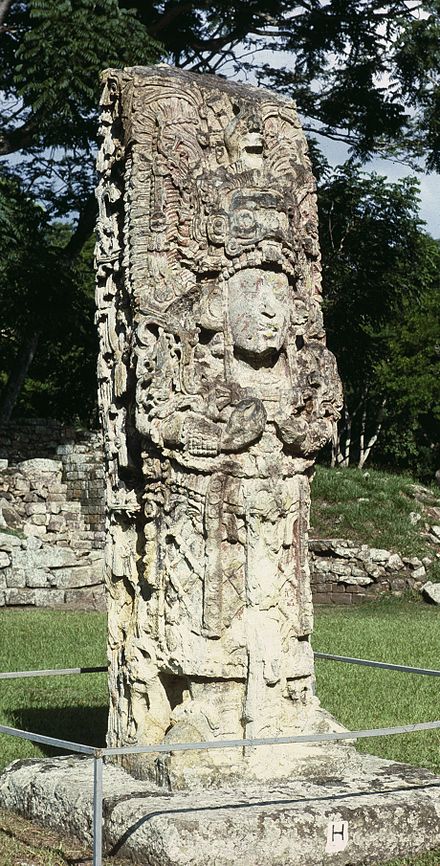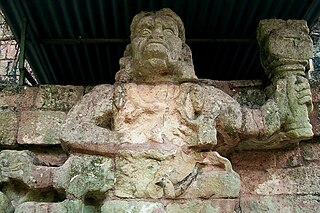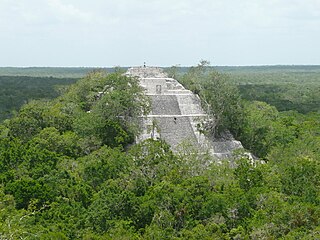
Quiriguá is an ancient Maya archaeological site in the department of Izabal in south-eastern Guatemala. It is a medium-sized site covering approximately 3 square kilometres (1.2 sq mi) along the lower Motagua River, with the ceremonial center about 1 km (0.6 mi) from the north bank. During the Maya Classic Period (AD 200–900), Quiriguá was situated at the juncture of several important trade routes. The site was occupied by 200, construction on the acropolis had begun by about 550, and an explosion of grander construction started in the 8th century. All construction had halted by about 850, except for a brief period of reoccupation in the Early Postclassic. Quiriguá shares its architectural and sculptural styles with the nearby Classic Period city of Copán, with whose history it is closely entwined.

Kʼinich Yax Kʼukʼ Moʼ is named in Maya inscriptions as the founder and first ruler, kʼul ajaw, of the pre-Columbian Maya civilization polity centered at Copán, a major Maya site located in the southeastern Maya lowlands region in present-day Honduras. The motifs associated with his depiction on Copán monuments have a distinct resemblance to imagery associated with the height of the Classic-era center of Teotihuacan in the distant northern central Mexican region, and have been interpreted as intending to suggest his origins and association with that prestigious civilization. One of the most commonly cited motifs for this interpretation is the "goggle-eyed" headdress with which Yax Kʼukʼ Moʼ is commonly depicted; this is seemingly an allusion to the northern central Mexican rain deity known as Tlaloc by later peoples, such as the Aztecs. However, modern strontium isotope analysis of the human remains recovered from the tomb attributed to him indicate that Kʼinich Yax Kʼukʼ Moʼ spent his formative years much closer to Copán, at Tikal, and had not himself lived at Teotihuacan.

Kʼakʼ Tiliw Chan Yopaat, previously known variously as Cauac Sky, Kawak Sky, Butsʼ Tiliw and Butzʼ Tiʼliw, was the greatest leader of the ancient Maya city-state of Quiriguá.

Yikʼin Chan Kʼawiil also known as Ruler B, Yaxkin Caan Chac and Sun Sky Rain,, was an ajaw of the Maya city of Tikal. He took the throne on December 8, 734.

Kʼahkʼ Pulaj Chan Chaahk, also known as Lord Chac before the decipherment of his corresponding name glyphs, is currently the only archaeologically identified ruler of the pre-Columbian Maya polity at Uxmal, who ruled in the early 10th century. Only a handful of details are known from this king, as hieroglyphic inscriptions, while very prominent in the Southern Maya Lowlands, are scarce in the north. What is known is that Lord Chac acceded to the throne somewhere at the end of the 9th century. During his rule, between 890-910 AD, some of the largest and most impressive buildings in Uxmal, such as the so-called Nunnery Quadrangle and the Governor's Palace, were built. An inscription at a large ballcourt in Uxmal, for playing the Mesoamerican ballgame, informs us it was dedicated in 901 during the reign of this king.

During the 7th and 8th centuries in Mesoamerica, there was an evident shift in the roles women played in ancient Maya society as compared with the previous two centuries. It was during this time that there was a great deal of political complexity seen both in Maya royal houses as well as in the Maya area. Warfare was a significant factor in political competition and marriage was one of the ways that alliances were made between the different polities. This was accompanied by a shift in women's roles from wife and mother to playing integral parts in courtly life, such as participating in rituals involving the supernatural world and at times ruling individual polities.

Bʼalaj Chan Kʼawiil was a Maya ruler of Dos Pilas. He is also known as Ruler 1, Flint Sky God K and Malah Chan Kʼawil.
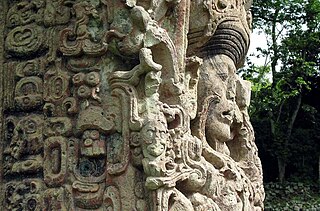
Maya stelae are monuments that were fashioned by the Maya civilization of ancient Mesoamerica. They consist of tall, sculpted stone shafts and are often associated with low circular stones referred to as altars, although their actual function is uncertain. Many stelae were sculpted in low relief, although plain monuments are found throughout the Maya region. The sculpting of these monuments spread throughout the Maya area during the Classic Period, and these pairings of sculpted stelae and circular altars are considered a hallmark of Classic Maya civilization. The earliest dated stela to have been found in situ in the Maya lowlands was recovered from the great city of Tikal in Guatemala. During the Classic Period almost every Maya kingdom in the southern lowlands raised stelae in its ceremonial centre.

Yuknoom Yichʼaak Kʼahkʼ ) or Yuknoom Ixquiac was a Maya king of the Kaan kingdom, which had its capital at Calakmul during the Classic Period of Mesoamerican chronology.

Bolon Kʼawiil II was a Maya king of Calakmul (>771-789?>). His monuments are Stelae 57 and 58 in his city.

Kʼakʼ Chan Yopaat was the eleventh dynastic ruler at Copán. He was crowned as king in AD 578, 24 days after the death of Tzi-Bʼalam. At the time of his rule Copán was undergoing an unprecedented rise in population, with residential land use spreading to all available land in the entire Copán Valley. The two surviving stelae of Kʼakʼ Chan Yopaat contain long hard-to-decipher hieroglyphic texts and are the oldest monuments at the site to survive without being either broken or buried. He had a long reign, ruling at Copán for 49 years, and he died on 5 February 628. His name is recorded on four stelae erected by his successors, one of which describes a rite performed with relics from his tomb in AD 730, almost a hundred years after his death.
Chan Imix Kʼawiil was the twelfth ruler of the Maya city state Copán. His nickname was Smoke Jaguar.
Kʼakʼ Joplaj Chan Kʼawiil was installed as the 14th dynastic ruler of Copán on 7 June 738, 39 days after the execution of Uaxaclajuun Ubʼaah Kʼawiil. Little is known of his reign due to the lack of monuments raised after Quiriguá's surprise victory. Copán's defeat had wider implications due to the fracturing of the city's domain and the loss of the key Motagua River trade route to Quiriguá. The fall in Copán's income and corresponding increase at Quiriguá is evident from the massive commissioning of new monuments and architecture at the latter city and Copán may even have been subject to its former vassal. Kʼakʼ Joplaj Chan Kʼawiil died in January 749.

Kʼakʼ Yipyaj Chan Kʼawiil was a ruler of the Mayan city of Copán. He was the son of Kʼakʼ Joplaj Chan Kʼawiil. The early period of his rulership fell within Copán's hiatus but later on he began a programme of renewal in an effort to recover from the earlier disaster of the city. He built a new version of Temple 26, with the Hieroglyphic Stairway being reinstalled on the new stairway and doubled in length. Five life-size statues of seated rulers were installed seated upon the stairway. Kʼakʼ Yipyaj Chan Kʼawiil died in the early 760s and is likely to have been interred in Temple 11, although the tomb has not yet been excavated.

The Third Tikal–Calakmul War was the third in a series of wars between Tikal and Calakmul, two of the Major superpowers of the Maya Civilization during the classic period.
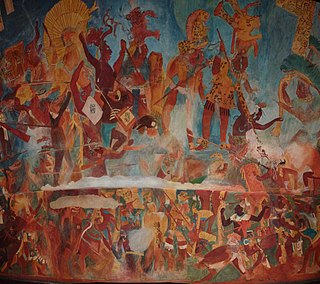
The Tikal–Calakmul wars were a series of wars, mainly between Tikal and Calakmul on the Yucatán Peninsula, but also with vassal states in the Petén Basin such as Copan, Dos Pilas, Naranjo, Sacul, Quiriguá, and briefly Yaxchilan had a role in initiating the first war.

The history of Maya civilization is divided into three principal periods: the Preclassic, Classic and Postclassic periods; these were preceded by the Archaic Period, which saw the first settled villages and early developments in agriculture. Modern scholars regard these periods as arbitrary divisions of chronology of the Maya civilization, rather than indicative of cultural evolution or decadence. Definitions of the start and end dates of period spans can vary by as much as a century, depending on the author. The Preclassic lasted from approximately 2000 BC to approximately 250 AD; this was followed by the Classic, from 250 AD to roughly 950 AD, then by the Postclassic, from 950 AD to the middle of the 16th century. Each period is further subdivided:

